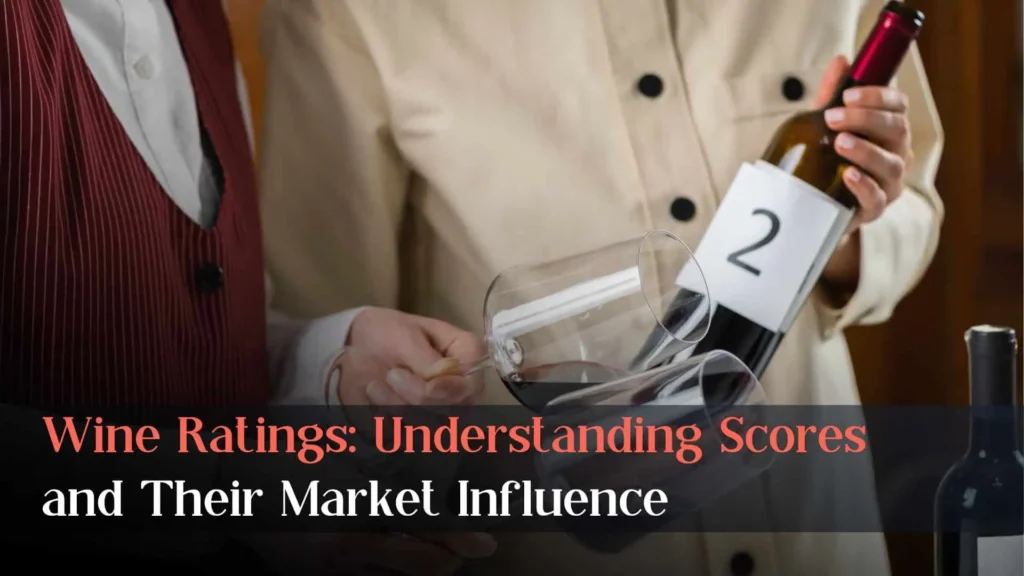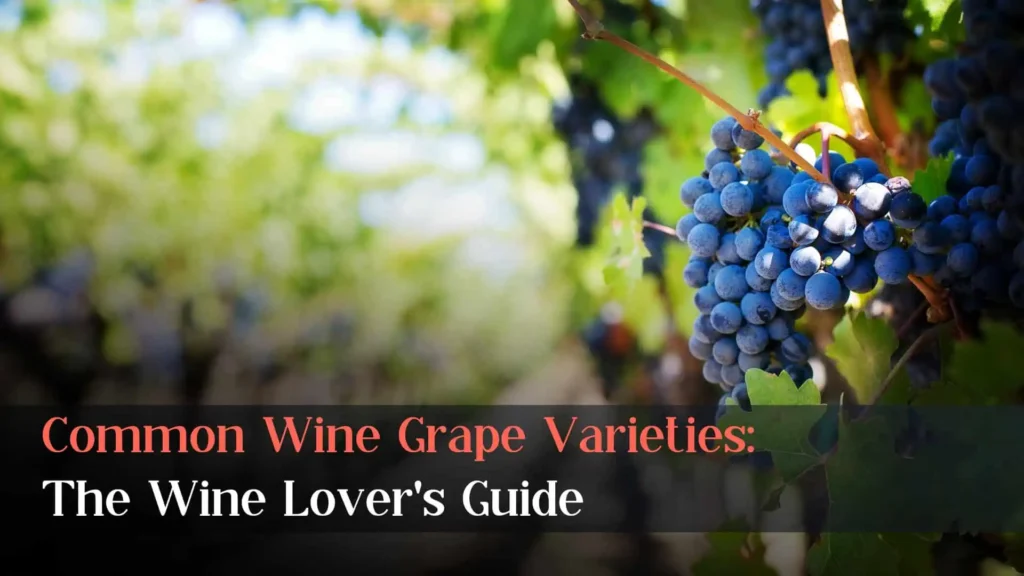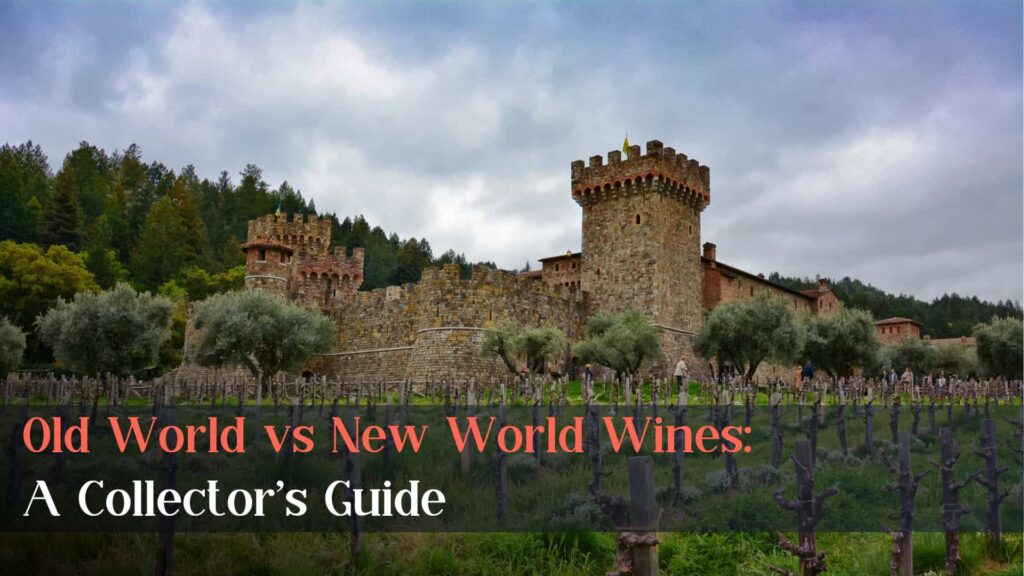Have you ever found yourself standing in a wine shop, staring at rows of bottles adorned with colorful tags displaying bold numbers? Or perhaps you’ve browsed online wine retailers, wondering what those scores next to each wine really mean.
Welcome to the world of wine ratings – a realm that can be both enlightening and bewildering for wine enthusiasts and collectors alike.
In this comprehensive guide, we’ll demystify wine ratings, exploring their significance in the industry and how you can use them to enhance your wine experiences.
Table of Contents
ToggleThe Importance of Wine Ratings
Wine ratings have become an integral part of the wine industry since their popularization in the 1970s. These scores, typically ranging from 50 to 100 points, serve multiple purposes:
- Quality Indicator: Ratings provide a quick reference for the perceived quality of a wine.
- Buying Guide: Consumers often use ratings to inform their purchasing decisions.
- Investment Tool: Ratings can influence a wine’s market value and investment potential.
- Marketing Asset: Wineries use high scores in their marketing efforts to promote their products.
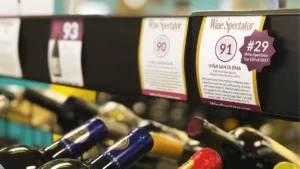
While ratings are undoubtedly influential, it’s important to remember that they are just one tool in the wine lover’s arsenal. Personal taste, food pairings, and individual experiences all play crucial roles in wine appreciation.
The Basics of Wine Scoring
The 100-Point System
The most widely recognized wine quality rating system is the 100-point scale, popularized by wine critic Robert Parker in the 1970s. Despite its name, this system actually starts at 50 points, not zero. Here’s a general breakdown:
- 95-100: Extraordinary
- 90-94: Outstanding
- 85-89: Very good
- 80-84: Good
- 75-79: Mediocre
- Below 75: Not recommended
It’s worth noting that the vast majority of commercially available wines score between 80 and 95 points. Scores below 80 are rarely published, as critics tend to focus on highlighting good wines rather than criticizing poor ones.
Other Scoring Systems
While the 100-point system dominates, other wine score methods exist:
- 20-Point Scale: Used by some European critics and publications, this system provides a more nuanced evaluation but can be less intuitive for consumers accustomed to percentages.
- 5-Star System: Similar to restaurant or hotel ratings, this straightforward system is easy to understand but offers less granularity than point-based scales.
- Letter Grades: Some critics use A to F grades, sometimes with plus and minus modifiers for additional precision.
What Makes a Quality Wine Rating?

A reliable wine quality rating should consider several factors:
- Appearance: Color, clarity, and viscosity
- Aroma: Intensity, complexity, and specific scent notes
- Flavor: Taste, body, and balance
- Finish: Length and pleasantness of the aftertaste
- Overall Impression: How the above elements come together
Professional critics often use a detailed wine score sheet to systematically evaluate these aspects. However, it’s important to remember that even with these criteria, there’s an element of subjectivity in every rating.
In the next section, we’ll explore some of the major wine rating websites and publications, helping you navigate the sea of scores and find trusted sources for your wine explorations.
Major Wine Rating Websites and Publications
In the vast world of wine criticism, several key players stand out for their influence and reach. These wine rating websites and publications have become go-to resources for enthusiasts, collectors, and industry professionals alike.
Let’s explore some of the most prominent sources and their unique approaches to wine evaluation.
Overview of Popular Wine Rating Websites
The internet has revolutionized how we access wine information. Today, numerous wine rating websites offer scores, tasting notes, and buying advice at our fingertips. Some of the most visited include Wine Spectator, Robert Parker’s Wine Advocate, Wine Enthusiast, JamesSuckling.com, and Jebdunnuck.com.
These sites often require a subscription for full access, but they provide a wealth of information for serious wine lovers.
How to Use These Resources Effectively
When using wine rating websites, consider the following tips:
- Compare scores from multiple sources for a well-rounded view.
- Read the tasting notes, not just the scores.
- Pay attention to the critic’s preferences and how they align with yours.
- Use the search and filter functions to find wines that match your interests and budget.
Now, let’s delve into some of the most influential rating sources:
1. Wine Spectator (WS)

History and Influence: Founded in 1976, Wine Spectator has become one of the most recognized names in wine criticism. Its annual Top 100 list is highly anticipated in the wine world and can significantly impact a wine’s market value.
Tasting Methodology: Wines are tasted blind by editors in peer-group flights. This means the tasters know the general type of wine (e.g., Napa Cabernet Sauvignon from the 2018 vintage) but not the producer or price.
Scoring System: Wine Spectator uses the 100-point scale:
- 95-100: Classic: a great wine
- 90-94: Outstanding: a wine of superior character and styl
- 85-89: Very good: a wine with special qualities
- 80-84: Good: a solid, well-made wine
- 75-79: Mediocre: a drinkable wine that may have minor flaws
- 50-74: Not recommended
2. Robert Parker’s Wine Advocate (WA)

History and Influence: Robert Parker revolutionized wine criticism with his 100-point scale in the 1970s. His scores, particularly for Bordeaux wines, have been known to make or break a vintage’s reputation. Although Parker has since retired, his legacy continues through The Wine Advocate.
Tasting Methodology: Unlike Wine Spectator, Wine Advocate does not taste blind. Critics know the producer and other details about the wine, which they argue provides important context for evaluation.
Scoring System: The Wine Advocate’s 100-point scale is slightly different:
- 96-100: An extraordinary wine of profound and complex character displaying all the attributes expected of a classic wine of its variety. Wines of this caliber are worth a special effort to find, purchase and consume.
- 90-95: An outstanding wine of exceptional complexity and character. In short, these are terrific wines.
- 80-89: A barely above average to very good wine displaying various degrees of finesse and flavor as well as character with no noticeable flaws.
- 70-79: An average wine with little distinction except that it is a soundly made. In essence, a straightforward, innocuous wine.
- 60-69: A below average wine containing noticeable deficiencies, such as excessive acidity and/or tannin, an absence of flavor or possibly dirty aromas or flavors.
- 50-59: A wine deemed to be unacceptable.
3. Wine Enthusiast (WE)

History and Influence: Wine Enthusiast began as a wine accessories catalog in 1979 and has since grown into a major wine publication and rating source. It’s known for covering a wide range of wines, including many affordable options.
Tasting Methodology: Wines are tasted blind by region and variety. Reviewers know the general type of wine but not the producer or price, similar to Wine Spectator’s approach.
Scoring System:
- 98-100: Classic
- 94-97: Superb
- 90-93: Excellent
- 87-89: Very Good
- 83-86: Good
- 80-82: Acceptable
4. Decanter (D/DC)

History and Influence: Founded in 1975, Decanter is one of the oldest consumer wine publications. It has a strong international following and is particularly influential in the UK and European markets. Their annual Decanter World Wine Awards is one of the largest wine competitions globally.
Tasting Methodology: Decanter uses expert panels for its tastings, often bringing together specialists for specific regions or styles. This panel approach is unique among major publications and aims to provide a consensus view on wines.
Scoring System: In addition to the 100-point scale, Decanter awards medals in its tastings:
- 95-100 points: Gold Medal
- 90-94 points: Silver Medal
- 86-89 points: Bronze Medal
- 83-85 points: Commended
5. James Suckling (JS)

History and Influence: James Suckling, formerly of Wine Spectator, launched his own website in 2010. He’s known for his influence in Italian wines and has expanded to cover other major wine regions globally.
Tasting Methodology: Suckling and his team taste thousands of wines each year, often visiting wineries directly. They typically taste non-blind, arguing that knowing the producer and vintage provides important context.
Scoring System:
- 95-100: Superb
- 90-94: Outstanding
- 85-89: Very good
- 80-84: Good
6. Jeb Dunnuck (JD)

History and Influence: Jeb Dunnuck began with The Rhone Report in 2008, later joining Robert Parker’s Wine Advocate in 2013. In 2017, he launched his independent website, JebDunnuck.com. He’s known for his expertise in Rhône, Bordeaux, California, and Washington wines.
Tasting Methodology: Dunnuck typically tastes wines non-blind, arguing that knowing the producer and vintage provides important context for evaluation. He’s known for his comprehensive tasting notes.
Scoring System: Dunnuck uses a 100-point scale:
- 98-100: As good as it gets
- 94-97: Outstanding wines of exceptional quality
- 90-93: Outstanding wines
- 85-89: Very good to good wines
- 80-84: Above average to average wines
- Below 80: Various levels of below-average wines
Dunnuck’s influence has grown significantly since launching his independent platform, particularly for Rhône varieties and Bordeaux.
By understanding these major wine rating websites and publications, you can better navigate the world of wine scores and make more informed decisions about your wine purchases. Remember, while these ratings are valuable tools, they should be used in conjunction with your own tastes and experiences to guide your wine experience.
V. The Relationship Between Wine Prices and Ratings
The connection between wine prices and ratings is complex and often misunderstood. While high ratings can certainly drive up prices, the relationship isn’t always straightforward. Let’s dive into some data that illustrates this relationship.
How Ratings Influence Wine Prices
High scores from respected critics significantly impact a wine’s market value, especially for those rated 90 points or above. Studies have quantified this relationship such as The Cambridge University Press’s research which found that a one-point increase in expert ratings corresponded to an 8% price jump for Bordeaux wines.
More dramatically, auctionforecast.com’s Vincast study revealed that wines rated above 88 points show exponential price increases, with 100-point wines fetching up to ten times the price of average-rated wines. This relationship is visually represented in a chart, showing price changes for a hypothetical $100 Bordeaux across various ratings.
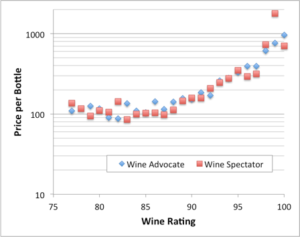
Change in price for a hypothetical $100 bottle of Bordeaux wine with various ratings. [Image Source]
Even across the broader market, a 2001 study from the University Avenue Undergraduate Journal of Economics found that each 1-point rating increase correlates with an average price increase of $10.62. These findings underscore the significant influence of critics’ scores on wine valuation in the marketplace.
Finding Value: High-Rated Wines at Reasonable Prices
Despite the potential for price inflation, savvy consumers can still find excellent value in the world of rated wines. Here are a few strategies to finding great wines.
One good tip is to look for wines in the 87-89 point range. These are often high-quality wines that haven’t seen the price bump associated with 90+ scores. Also pay attention for value picks like Wine Enthusiast’s “Best Buy” selections which are released annually.
VIII. The Impact of Ratings on the Wine Industry
Wine ratings have profoundly influenced the wine industry since their popularization in the late 20th century.
How High Scores Affect Wineries and Sales
A high score from a respected critic can be a game-changer for a winery:
- Increased Demand: High-scoring wines often sell out quickly, sometimes even before they’re bottled (in the case of wine futures).
- Brand Recognition: Consistently high scores can elevate a winery’s reputation, leading to long-term benefits.
- Pricing Power: Wineries with highly-rated wines often have more flexibility in their pricing strategies.

Wineries with consistently high scores like Domaine De La Romanée-Conti often see substantial price appreciation.
Criticisms of the Rating System
Despite their influence, wine ratings are not without controversy:
- Subjectivity: Critics argue that personal taste plays too large a role in scoring.
- Standardization: The 100-point scale can oversimplify the complex world of wine.
- Stylistic Bias: Some argue that certain critics favor particular wine styles, potentially influencing winemaking trends.
- Pressure on Winemakers: The pursuit of high scores may lead some winemakers to alter their styles to please critics rather than staying true to their vision or terroir.
Conclusion
Wine ratings have become an integral part of the wine world, offering guidance to consumers and significantly impacting the industry. While they’re a valuable tool for discovering new wines and understanding quality, it’s crucial to remember they’re just one aspect of wine appreciation.
As you continue your wine journey, use ratings as a starting point, but don’t hesitate to explore beyond the numbers. Develop your palate, try wines from different regions, and most importantly, trust your own preferences. After all, the best wine is the one you enjoy drinking, regardless of its score.
